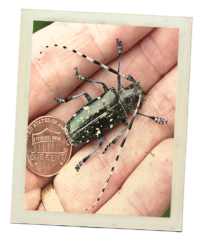
Other names: Asian longhorned beetle, starry night beetle, Anoplophora glabripennis
Plants susceptible: all maples (esp. sugar maple), horse chestnut, birch, willow, elm, + many more species
Where did it come from?
Asian longhorned beetle has been repeatedly introduced from its native range in China.
Why is it invasive?
Asian longhorned beetle kills the trees it attacks by hollowing them out and cutting off their supply of nutrients. Although it generally takes about 10 years to kill a tree, once a tree is infested it cannot be saved.
How do you prevent its spread?
You can help prevent its spread by not moving wood it could be hiding in like firewood. Regularly inspecting your trees for ALB and making a report of you think you’ve found signs of it. This beetle can be eradicated if caught early in an invasion. This beetle is 1 to 1.5 inches in length with long antennae that are banded black and white. Check for dime-sized or smaller exit holes in tree trunks or branches, shallow oval or round scars in tree bark, and sawdust-like material on the ground around the tree.
Resources:
♦ Learn how to identify the beetle and signs of damage.
Seen it? Report it! Through the app, online, by email, or by phone (1-866-663-9684).
Image credit: